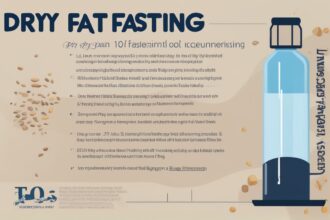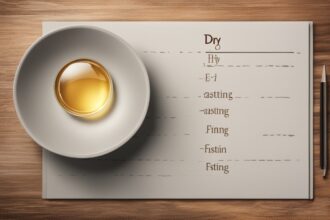Have you ever considered pushing your body’s limits by abstaining not just from food, but from water too? Welcome to the world of dry fasting, a practice that’s been gaining traction among health enthusiasts and spiritual seekers alike. Unlike traditional water fasting, dry fasting involves completely refraining from both food and liquids for a set period. While it’s rooted in ancient traditions and religious practices, modern interest has sparked debates about its potential health benefits and risks. In this comprehensive guide, I’ll walk you through what dry fasting is, why people do it, the science (or lack thereof) behind it, and how to approach it safely if you’re curious to try. Let’s dive into this intriguing yet controversial fasting method with an open mind and a focus on well-being.
What Is Dry Fasting and How Does It Differ from Other Fasts?
At its core, dry fasting is a form of fasting where you consume neither food nor water for a specific duration. This sets it apart from other popular fasting methods like intermittent fasting, where you might skip meals but still hydrate, or water fasting, where liquids are allowed. Dry fasting can be further categorized into “soft” dry fasting—where you avoid drinking but may come into contact with water through activities like showering—and “hard” dry fasting, where even external water contact is minimized. The practice often lasts anywhere from 12 hours to several days, though longer durations are rare and highly debated due to health concerns. Historically, dry fasting has been part of religious observances, such as during Ramadan for Muslims, where participants abstain from food and drink from dawn to dusk (Khan & Jialal, 2020). Today, many are drawn to it for purported health benefits like detoxification and weight loss, though scientific evidence remains limited.
The Potential Benefits of Dry Fasting: What Does Science Say?
Proponents of dry fasting often claim it offers unique benefits beyond those of water fasting, such as enhanced detoxification, cellular repair, and even spiritual clarity. While personal anecdotes abound, let’s look at what science has to say. One of the primary mechanisms thought to be at play during dry fasting is autophagy, a process where the body breaks down and recycles damaged cells. Research on water fasting suggests that autophagy is triggered during prolonged calorie restriction (Bagherniya et al., 2018), and some hypothesize that the added stress of dehydration in dry fasting could amplify this effect, though direct studies are lacking. Additionally, short-term dry fasting may lead to rapid weight loss due to the depletion of glycogen stores and associated water weight (Johnstone, 2015). However, much of this weight is regained once hydration resumes. There’s also interest in its potential anti-inflammatory effects, as fasting in general has been linked to reduced markers of inflammation (Faris et al., 2012). Still, without robust clinical trials specifically on dry fasting, these benefits remain speculative for now.
Many who practice dry fasting also report a sense of mental clarity or heightened focus, which could be tied to the production of ketones—a byproduct of fat burning that serves as an alternative energy source for the brain during fasting (Mattson et al., 2018). Whether this is unique to dry fasting or simply a result of caloric restriction is unclear. What’s important to note is that while these potential perks sound promising, they come with significant caveats, which we’ll explore shortly.
The Risks and Challenges of Dry Fasting
Let’s be real—dry fasting isn’t a walk in the park, and it’s not without serious risks. Dehydration is the most immediate concern, as the human body relies on water for nearly every function, from regulating temperature to flushing out toxins. Even mild dehydration can cause symptoms like dizziness, fatigue, and headaches, while severe dehydration can lead to kidney damage or electrolyte imbalances (Popkin et al., 2010). Prolonged dry fasting—beyond 24–48 hours for most people—can strain the body significantly, especially if you’re not well-prepared or have underlying health conditions. There’s also the risk of overdoing it in pursuit of quick results, which can lead to fainting or worse.
Another challenge is the lack of long-term research. While intermittent dry fasting during religious practices like Ramadan has been studied and shown to be generally safe for healthy individuals (Khan & Jialal, 2020), extended or frequent dry fasting outside these contexts hasn’t been thoroughly investigated. This means we’re often relying on anecdotal reports rather than hard data. If you’re considering this practice, it’s crucial to weigh these risks against any perceived benefits and consult a healthcare provider, especially if you have conditions like diabetes, kidney issues, or heart problems.
How to Practice Dry Fasting Safely: Practical Tips
If you’ve decided to give dry fasting a try, preparation and caution are your best friends. This isn’t something to jump into without a plan, as the body needs time to adapt to such an intense practice. Below are some practical tips to help you approach dry fasting with safety and mindfulness in mind:
- Start Small: If you’re new to fasting, don’t dive into a multi-day dry fast. Begin with a short window, like 12–16 hours, to test how your body responds. Gradually increase duration only if you feel comfortable.
- Hydrate Well Before and After: In the days leading up to your fast, drink plenty of water to ensure your body is well-hydrated. After breaking the fast, rehydrate slowly with small sips of water to avoid overwhelming your system.
- Choose the Right Time: Avoid dry fasting during extreme heat or when you have physically demanding tasks. Opt for a restful day where you can relax and listen to your body.
- Break the Fast Gently: Don’t rush into heavy meals or large amounts of water right after. Start with a small glass of water or a light broth to ease your digestive system back into action.
- Listen to Your Body: If you feel lightheaded, nauseous, or excessively weak, stop immediately. Dry fasting isn’t a competition—your health comes first.
Who Should Avoid Dry Fasting?
While dry fasting might intrigue some, it’s definitely not for everyone. Certain groups should steer clear due to the heightened risks involved. If you fall into any of these categories, consider alternative fasting methods or consult a medical professional before proceeding:
- Pregnant or Breastfeeding Women: Dehydration and nutrient deprivation can harm both mother and child.
- Individuals with Chronic Conditions: Those with diabetes, kidney disease, or heart issues may experience dangerous complications.
- Children and Elderly: Younger and older individuals are more vulnerable to dehydration and electrolyte imbalances.
- People with Eating Disorders: Dry fasting could exacerbate unhealthy relationships with food or body image.
Even if you’re in good health, it’s wise to get a green light from your doctor, especially if you plan to fast for more than 24 hours. Remember, fasting—whether dry, water, or intermittent—should enhance your well-being, not jeopardize it.
Dry Fasting in Cultural and Spiritual Contexts
Beyond health trends, dry fasting holds deep significance in various cultural and spiritual traditions. As mentioned earlier, Ramadan is one of the most well-known examples, where millions of Muslims worldwide fast from food and water during daylight hours for a month. This practice is not just about physical abstinence but also spiritual reflection and discipline. Similarly, certain Christian denominations practice dry fasting during Lent or other holy periods as a form of penance and connection to faith. In some indigenous and shamanic traditions, dry fasting is used as a tool for vision quests or spiritual cleansing, often under guided supervision. While the health impacts of these practices vary, they highlight how dry fasting isn’t just a modern fad—it’s a ritual with roots stretching back centuries. Understanding this context can add depth to your own fasting journey, even if your goals are purely physical.
In wrapping up, dry fasting is a fascinating yet polarizing practice that straddles the line between ancient tradition and modern health experimentation. It offers potential benefits like weight loss, mental clarity, and possibly enhanced cellular repair, but these come with significant risks, particularly dehydration and physical strain. The science is still catching up, so much of what we know is based on related fasting research or personal experiences. If you’re curious about trying dry fasting, start small, prioritize safety, and always listen to your body’s signals. Remember that fasting is just one tool among many for health and wellness—balance and moderation are key. Have you tried dry fasting, or are you considering it? I’d love to hear your thoughts or questions in the comments below. Let’s keep the conversation going as we explore ways to live healthier, more intentional lives.
References
- Bagherniya, M., Butler, A. E., Barreto, G. E., & Sahebkar, A. (2018). The effect of fasting or calorie restriction on autophagy induction: A review of the literature. Ageing Research Reviews, 47, 183–197. https://doi.org/10.1016/j.arr.2018.08.004
- Faris, M. A., Kacimi, S., Al-Kurd, R. A., Fararjeh, M. A., Bustanji, Y. K., Mohammad, M. K., & Salem, M. L. (2012). Intermittent fasting during Ramadan attenuates proinflammatory cytokines and immune cells in healthy subjects. Nutrition Research, 32(12), 947–955. https://doi.org/10.1016/j.nutres.2012.06.021
- Johnstone, A. (2015). Fasting for weight loss: An effective strategy or latest dieting trend? International Journal of Obesity, 39(5), 727–733. https://doi.org/10.1038/ijo.2014.214
- Khan, M. A., & Jialal, I. (2020). Effects of Ramadan fasting on glucose homeostasis and inflammatory markers: A systematic review. Diabetes Research and Clinical Practice, 168, 108374. https://doi.org/10.1016/j.diabres.2020.108374
- Mattson, M. P., Moehl, K., Ghena, N., Schmaedick, M., & Cheng, A. (2018). Intermittent metabolic switching, neuroplasticity and brain health. Nature Reviews Neuroscience, 19(2), 63–80. https://doi.org/10.1038/nrn.2017.156
- Popkin, B. M., D’Anci, K. E., & Rosenberg, I. H. (2010). Water, hydration, and health. Nutrition Reviews, 68(8), 439–458. https://doi.org/10.1111/j.1753-4887.2010.00304.x






